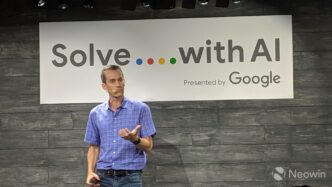AI spending is surging, and so are the cloud bills that come with it. Cloud services are already expensive, but generative AI is driving those costs even higher. In fact, Gartner projects that global public cloud spending will hit $723.4 billion by 2025, jumping from just under $600 billion in 2024. According to IBM, 70% of executives point to generative AI as a key contributor to that sharp rise.
A recent example makes the urgency clear. Chinese AI firm DeepSeek claimed it spent only $6 million and two months to train a powerful model. Whether or not those numbers reflect the full story, the shockwaves were real. Microsoft and Nvidia saw stock reactions, highlighting how seriously the tech world is now taking AI cost efficiency.
Until recently, most companies could write off AI expenses as part of research and development. But that’s changing. AI costs tied to profitable products are now creeping into cost of goods sold (COGS), putting pressure on gross margins. DeepSeek’s claim didn’t just make headlines—it shortened the runway before AI spending gets the full financial spotlight.
To stay competitive, businesses must get smarter about managing both the training and ongoing operational costs of AI. That means connecting spending to performance, refining pricing strategies, and increasing the return on every AI dollar.
One proven method? Cloud unit economics (CUE).
CUE is all about linking cloud spending to business outcomes. It helps companies identify where they’re profitable and where they’re bleeding cash. That includes AI-related expenses.
At the core of CUE is cost allocation—mapping cloud spending back to the teams, products, or features responsible for them. For example, businesses can break down costs by engineering team, product line, feature, or even by individual microservices. This structure typically mirrors a company’s internal setup, making insights easier to act on.
Once costs are properly allocated, companies can calculate unit cost metrics—such as the cost per 1,000 messages sent on a platform. By feeding both cloud usage and customer activity data into one system, companies get a clear view of the real cost to serve.
Even better, these metrics can be sliced across multiple views: by customer segment, product tier, team performance, and more. That flexibility reveals exactly where cloud costs are growing fastest and where to tighten the reins.
With this approach, businesses can:
- Identify cost hotspots across their infrastructure
- Optimize pricing models based on actual usage data
- Empower engineering teams to drive efficiency
- Refactor services or contracts where margins are tight
Applying CUE to AI Cost Management
AI-related spending fits naturally into the CUE model. While tracking AI costs is still evolving, modern platforms treat these expenses like any other cloud service—whether it’s AWS, GCP, or SaaS tools.
Using cloud cost management software, companies can allocate AI costs by engineering team, model type (like ML vs. foundation models), or by development stage. Want to know how much it costs to train a model versus run it in production? CUE makes that possible.
More granular tracking is also available. Businesses can monitor spending at each phase of AI development—data cleansing, storage, training, and inference. These breakdowns show exactly when and where costs spike, helping teams avoid surprises and stay on budget.
CUE gives companies the insight to balance innovation with efficiency. AI costs don’t have to be unpredictable—if they’re measured and managed.
Why AI Cost Management Can’t Wait
Despite the soaring price of cloud services, many companies still lack proper oversight. A 2024 CloudZero survey revealed that just 61% of companies had formal cost controls in place. Unsurprisingly, 31% of those without robust cost tracking saw cloud spending eat up 11% or more of their revenue.
As AI adoption accelerates, that risk only grows. Without clear cost visibility, organizations could see AI spending spiral out of control—dragging down margins and damaging growth potential.
Forward-thinking companies now treat cloud and AI expenses like any major investment. They calculate return on investment, analyze it across key business segments, and equip teams with the data they need to reduce waste. Next-gen platforms offering complete CUE workflows are crucial to this transformation.
Those who adopt these tools early won’t just cut costs—they’ll also gain a lasting edge in one of tech’s fastest-moving arenas.













